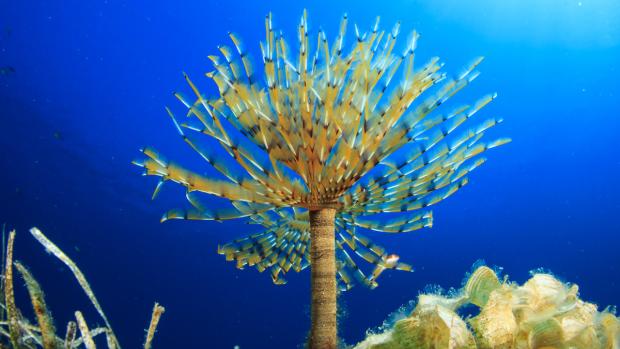Tandon researchers discover how deep-sea worms help keep natural gases on ice

An example of a feather duster worm (Sabellidae, Anelida). Photo Credit: Rich Carey
It is well known that natural gas hydrates, crystalline lattices of hydrogen-bonded water molecules that encapsulate small hydrocarbon molecules, on the ocean floors constitute both a potential accelerator of climate change and one of the greatest energy sources on Earth. But whether the huge amounts of natural gas that are so confined remain safely locked in crystalline hydrate cages, or are liberated into the ocean potentially to become atmospheric greenhouse gases, may depend in part on an unusual sea-floor symbiosis between worms and their microbial neighbors.
Researchers at the NYU Tandon School of Engineering discovered that this natural ecosystem involving feather duster worms (Sabellidae, Annelida) and both heat-generating and heat-absorbing bacteria (Archaea) that consume methane enclathrated — or locked into a crystalline structure — by hydrates in deep marine environments play a key role in maintaining equilibrium that keeps hydrates frozen.
Seeking to examine the influence that subtle temperature fluctuations may have on the dynamic stability of the hydrate deposits, the investigators, led by Ryan Hartman, professor of chemical and biomolecular engineering at NYU Tandon, found that feather duster worms, which thrive around crystalline hydrates, by selectively consuming heat-generating bacteria called methanotrophs that metabolize methane, put the brakes on the potential melting of these crystal structures (releasing trapped methane) due to the microbes’ exothermic metabolism.
In a newly published study, “Microbe-Worm Symbiosis Stabilizes Methane Hydrates in Deep Marine Environments,” in Energy & Fuels, researchers including lead author Tianyi Hua, Maisha Ahmad, and Tenzin Choezin, simulated the ecosystem by solving the associated energy balance and methane hydrate dissociation kinetics. They examined and analyzed the dissociation rate — the rate at which frozen hydrates disassembled into molecular components — and found that the symbiosis established among methanogens (methane-producing bacteria), methanotrophs, and feather duster worms indeed stabilizes methane hydrates at depths where the crystals are exposed to the ocean and its living organisms.
The implications are profound, as vast quantities of methane (200 to 500 gigatons of CH4), which form spontaneously from water and small hydrophobic molecules under specific temperature and pressure conditions, are stored as hydrates in the ocean worldwide.
“Our discovery shows mathematically the extent of symbiosis between microbes that consume methane hydrates and generate heat, and feather duster worms that consume these microbes,” said Hartman. “It’s important because, in the absence of the worms or an abnormal imbalance in their populations, these microbes could generate enough heat to melt the hydrates. The worms selectively eat bacteria that generate the most heat.”
To examine how warming oceans could disrupt this fragile balance, the team combined historical ocean temperature records and gas hydrate inventory estimates with their model; their findings suggest that hydrate deposits as deep as 560 meters below sea level could already be at risk, even if the ocean temperature ceases to rise, and the methane hydrate stability zone will retreat deeper as the ocean temperature rises. Also, decreases in the worm population could weaken the suppression on the methanotroph growth rate, and the consequent overgrowth of methanotroph would generate excess amounts of heat, destabilizing the hydrates further.
On the other hand, an increase in the methanogenic microbial activity would make the system more endothermic and thus strengthen the tolerance to temperature fluctuations close to the methane hydrate phase boundary.
“Slowing the retreat of this biological dynamic into deeper waters could help delay, or thwart the massive release of greenhouse gas into the sea,” he said. “Whether the gasses recrystallize or make it to the ocean’s surface is a much debated and important research topic”.




